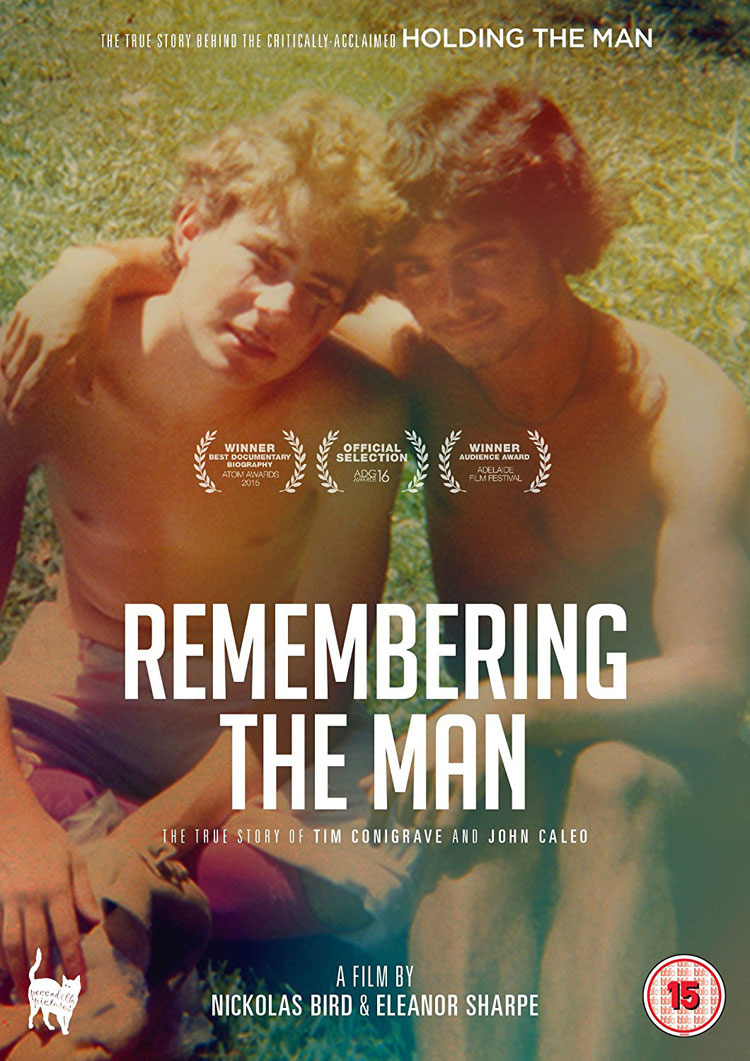
Director: Nickolas Bird, Eleanor Sharpe
Running Time: 83 mins
Certificate: 15
Release Date: June 12th 2017 (UK)

If you’ve read Timothy Conigrave’s 1995 memoir, Holding The Man, or seen the more recent film version (or indeed the play), you’ll know a bit about the relationship between Conigrave and John Caleo. This documentary retells the tale, focused around taped interviews Conigrave did with an AIDS oral history project before his death, as well as with interviews with the couple’s friends.
The documentary recounts how Timothy and John met as students at a Catholic High School in Australia and started to date one another. Despite a bit of tumult, break-ups and Timothy moving away to become an actor, the connection between the two remained and they developed an abiding love for one another.
However, this was the 1980s and gay men were being afflicted by a disease that was destroying their immune system and killing them. After Timothy does some work to raise awareness of HIV/AIDS, he and John discover they are HIV+. With no effective medications available at the time, they must face that they may not survive many more years.
Initially it’s difficult to understand exactly what Remembering The Man is for. If you’ve read the book or seen the film, you’ll know what happened, and so why do we need a documentary going over it again? However, it soon becomes apparent that there is value to it, not least giving voice to Timothy and John’s friends, who give their views about what happened, and show how loved they were – indeed, it nice how much of what Conigrave said is confirmed, and it wasn’t just his rose-coloured view of things.
It allows the movie to focus on the reality of the couple’s lives, and underline that they were not just words on a page or characters on the screen. What it also does well is put faces on the AIDS crisis. Quite often, documentaries about AIDS look at those who survived, or on the activism and anger that accompanied the emergence of the disease.
Here we look at two human beings, who were loved and special, but who were special in ways that are relatable to most people. By focussing on two individuals, they come to represent thousands of similar, forgotten stories of people whose lives were taken far too soon.
The documentary also allows both Conigrave and the couple’s friends to discuss the issues they faced in the late 70s and early 80s, not least that for many in society, the word ‘gay’ overwhelmed everything else about a person, and made it difficult for some to see them as people with loves, loves, hopes, dreams, angers and desires. Similarly, when AIDS came along, that was another thing that had a tendency to overwhelm the fact these were just people who’d been given what at the time was a terrible hand. Luckily Timothy and John did have plenty of people who could see past that, many of whom are interviewed here, and who still feel anger and sadness at what happened and how they were treated.
They certainly had more than their fair share of tribulations though, not least that John’s father insisted his son change his will shortly before his death so that nothing was left to Timothy, and then sorted it so that his son’s sexuality and lover was omitted from the funeral.
There’s also a certain eeriness to hearing Timothy’s extensive interviews, allowing him to speak from the grave (although it should be added the audio is an actor recreating what Conigrave said, based on transcripts). Again it’s a very personal touch that, coupled with the wealth of photographs and other documents (including a very moving letter from John), allows the documentary to feel like it’s Timothy telling his own story, rather than being constructed later by filmmakers. In many ways that was the point of the oral history project, so that those voices and lives that were likely to be cut short had the chance to talk about who they were and the experiences they had, to help ensure they wouldn’t be completely forgotten.
With his book and now this documentary, Conigrave has done an exceedingly admirable job of giving personal testimony to the AIDS crisis. Through the very individual love story of him and John, he has helped people to remember the many thousands of other people whose lives were taken.
The documentary also has the power to shock those lucky enough to have come of age after HIV become a manageable condition. It shows just how hideous a disease it was, and how cruel, protracted and painful people’s deaths were. And that’s before you add in the fear, bigotry and just plain nastiness those affected had to deal with, such as a pastor in the film advocating the firing squad for anyone who had AIDS.
Although there is still a faint whiff of having heard this story before, Remembering The Man is undoubtedly a worthwhile retelling of the tale. It amply demonstrates what a beautiful love story this was, while allowing the couple’s friends a voice and putting a face to a truly terrible crisis.
Overall Verdict: Remembering The Man quickly overcomes the fact this is a tale its main subject has told beautifully before, to shine a light on those around the love story and the reality of the AIDS epidemic.
Reviewer: Tim Isaac
Leave a Reply (if comment does not appear immediately, it may have been held for moderation)